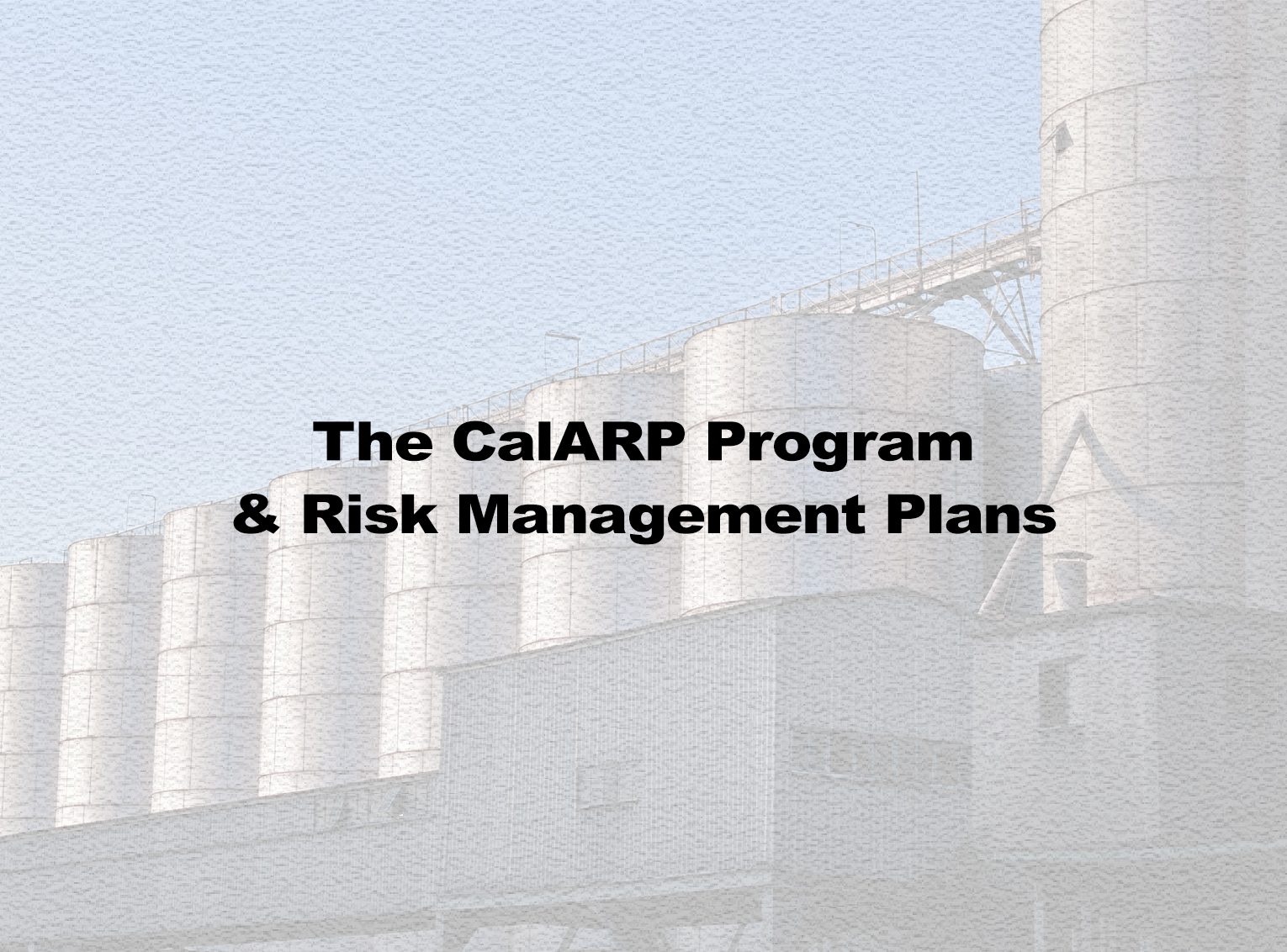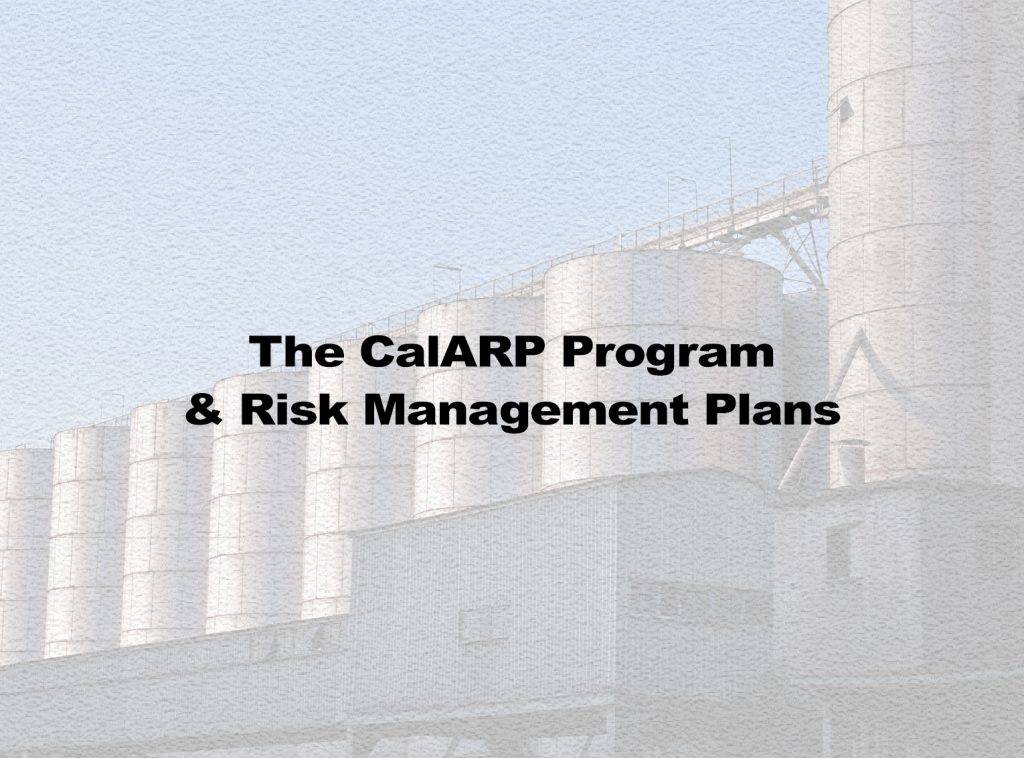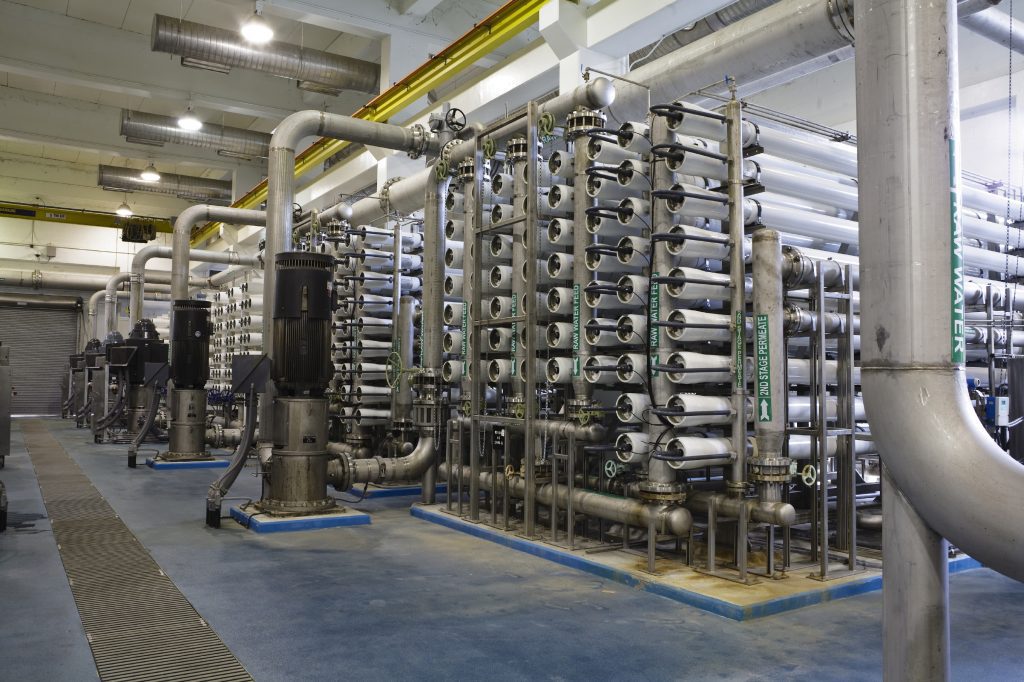
The CalARP Program & Risk Management Plans

Written by: Virginia McCormick, NES, Inc.

The CalARP Program may reduce the severity of consequences following accidental hazardous materials releases.
This article is part of a special dedicated series that covers California CUPAs and the Unified Program. For a complete overview, see the June 2019 NES article California CUPA Overview: Enforcing the CalEPA Unified Program.
The CalARP Program
On January 1, 1997, the California Governor’s Office of Emergency Services (Cal OES) implemented the CalARP Program as a replacement to the California Risk Management and Prevention Program. The goal of the CalARP Program was to, “reduce the likelihood and severity of consequences of extremely hazardous materials releases.” The program was adapted from the federal Chemical Accident Prevention Provisions and modified to include State-specific additions from Article 2, Chapter 6.95, of the California Health and Safety Code.
Through proactive measures, the CalARP Program requires that specific facilities take actions to prevent and prepare for chemical accidents. Businesses that handle more than a threshold quantity of a regulated substance listed in California Code of Regulations, Title 19, Section 2770.5 (19 CCR 2770.5) must develop a Risk Management Plan (RMP).
The CalARP Program, which includes the development and review of an RMP, is enforced by Certified Unified Program Agencies (CUPAs) and/or Participating Agencies (PAs).

As part of the Unified Program, the CalARP Program is enforced by CUPAs and/or PAs.
RMPs: The CalARP Program’s Core
As defined by Cal OES, a facility that meets the threshold quantity of a regulated substance (or chemical) outlined in 19 CCR 2770.5 is considered a “stationary source.” Under the CalARP Program, a stationary source may be required to develop and submit a Risk Management Plan (RMP). Often considered the most vital element of the CalARP Program, an RMP is a, “detailed engineering analysis of the potential accident factors present at a business and the mitigation measures that can be implemented to reduce this accident potential.”
An RMP is typically required to contain seven elements in order to be deemed sufficient by the business’s overseeing CUPA/PA. These elements are:
- Hazard review
- Safety information
- Operating procedures
- Training requirements
- Maintenance requirements
- Compliance audits
- Incident investigation procedures
Through these elements, an RMP may help organize and provide vital information that businesses, their workers, and potential first responders may use in the event of a release of hazardous materials.
Regulated substances are categorized into three tables in 19 CCR 2770.5. The categorization depends on whether the substance is regulated by the federal Clean Air Act or by the California Health & Safety Code and whether the substance is considered flammable or toxic. As explained in the Cal OES document California Accidental Release Prevention Program – Mixtures, the tables are as follows:
- Table 1 – the “Federal” table of toxic substances
- Table 2 – the “Federal” table of flammable substances
- Table 3 – the California-specific table of toxic substances
These tables define the thresholds for substances regulated by the CalARP Program. The thresholds are based on the maximum actual amount of the regulated substance contained at any one time. Mixtures of these regulated substances can occur. Threshold values for mixtures primarily depend on the nature of the mixture. As such, the recommended procedure for determining thresholds for mixtures is to contact the local Administrating Agency (typically a CUPA/PA) for assistance.
Submittal of an RMP depends on the types of regulated substances and threshold quantities of those substances. If the regulated substances are listed in Table 1 and/or Table 2, then an RMP must be submitted to both the local CUPA and the U.S. Environmental Protection Agency. If the substances are listed in Table 3, the RMP needs to be submitted to the local CUPA only. The RMP needs to be updated at least once every five years from the date of its initial submittal.

The requirements under the CalARP Program help to provide important information to first responders in the event of an accidental release.
CalARP Program Requirements: A “Holistic Approach”
While both the Hazardous Materials Business Plan (HMBP) Program and the CalARP Program specifications can be found under the same chapter of the California Health and Safety Code, the fulfillment requirements are distinct from each other. The HMBP Program focuses more on the reporting of a hazardous materials inventory, and the CalARP Program goes beyond reporting by requiring a more, “holistic approach to accident prevention and mitigation.”
For more information regarding California’s HMBP Program, check out the July 2019 NES article The Cal OES HMBP Program.
The focus of the CalARP Program is, “prevention through consideration of the entire facility,” rather than single functions or processes. While elements of the CalARP Program may differ slightly based on the stationary source, the general requirements include a hazard assessment, a prevention program, an emergency response program, and a management system.
These requirements not only satisfy federal and State Community Right-to-Know laws, but also provide information to, “first responders in order to prevent or mitigate damage to the public health and safety and to the environment from a release or threatened release of a hazardous material.”

The CalARP Program has four Program Levels that relate to the accident potential at the facility.
The Four Program Levels of the CalARP Program
Currently, the CalARP Program defines four “Program Levels” that indicate the accident potential at a facility. The CalARP Program distinguishes these levels depending on the process complexity, accident history, and potential off-site impact of a substance release. Process, as defined by Cal OES, means any activity involving a regulated substance. This includes use, storage, manufacturing, handling, or on-site movement of regulated substances.
Program Level 1 covers processes that pose low risks to the public.
Program Level 2 covers processes that exceed the Program Level 1 standards, but have fewer complex processes than Program Level 3 requirements. Some examples are retail facilities, small manufacturing facilities, and simple wastewater treatment plants.
Program Level 3 covers most of the complex chemical processes. These processes are in industrial sectors with substantial accident histories, that have significant potential off-site consequences, or are subject to the OSHA Process Safety Management (PSM) standard. Some examples are utility providers and facilities with large refrigeration storage systems.
Program Level 4 was adopted in October of 2017 and specifically covers petroleum refinery processes. The new level was implemented after gaps in the CalARP Program regulatory process were discovered and enhanced requirements were recommended by Cal OES.
The owner of a business or facility that is subject to the CalARP Program must communicate with the local CUPA in order to correctly identify the appropriate Program Level for each process.
NES Environmental Consulting
NES has been providing environmental consulting and training services for the past 30 years. NES regularly provides training on behalf of CUPAs and public and private businesses throughout California. For more information on how NES can help you navigate the CalARP Program, please contact us at office@nesglobal.net or 916-353-2360 / 1-800-NES-ADVISE.
References:
Cal OES: California Accidental Release Prevention
CalARP Program, Administering Agency Guidance
California Accidental Release Prevention Program – Mixtures
California Accidental Release Prevention Program FAQ
California CUPA Forum: California Accidental Release Prevention
Chemical Accident Prevention Provisions
